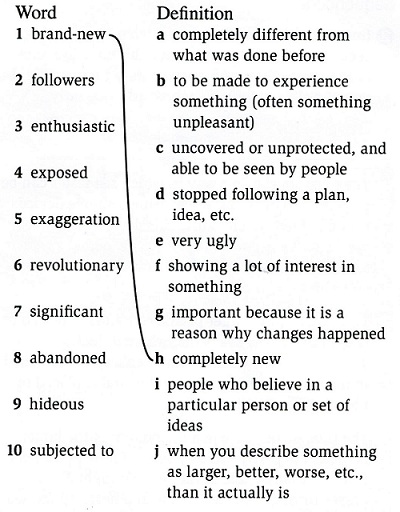IELTS HOPECO Reading: Unit 10 - Building Design (WB 4-5.5)
Multiple choice
1. You are going to read a passage about a famous architect called Le Corbusier. Read the passage quickly then match the words (1-10), in bold in the passage, with their correct definition (a-j).

The man who tried to destroy ParisLe Corbusier was one of the most influential architects of the 20th century. But many may wish he had never built anythingBorn Charles-Edouard Jeanneret in Switzerland in 1887, the architect Le Corbusier used his grandfather's name when he went to Paris at the age of 29. As Jeanneret, he had been a fairly successful small-town architect; as Le Corbusier, he had bigger ideas. He disliked the architectural styles that were popular at the time, and considered them to be out of date in an industrial age. He believed that the 20th century deserved a brand-new style of architecture. "We must start again from zero," he said. The new style of architecture was called the International Style, and it attracted many followers in the architectural world. However, nobody was as enthusiastic about it as Le Corbusier at the beginning. He worked hard to promote his ideas at exhibitions, at talks, in books and in his own magazine. He loved machines, and believed that, like a machine, a building should have a function. He is famous for saying: "A house is a machine for living in." The machines he admired the most were ships, and his early buildings tried to capture the spirit of the sea with their white walls, exposed rooms, shining glass and flat roofs. He called this style of architecture 'purism'. The first building to embrace this style was the Villa Savoye in France. Le Corbusier believed that it was one of the best, most functional houses ever built. Unfortunately, this turned out to be an exaggeration. The flat roof was a particular problem, as water poured in every time it rained, and it needed constant repairs. Nevertheless, its design was revolutionary, and it should be considered a significant piece of early 20th-century architecture. In 1935, Le Corbusier visited New York City. He loved the city, and especially its tall buildings. He had only one reservation, which he explained to a journalist for the Herald Tribune newspaper. American skyscrapers were the biggest, tallest buildings in the world at that time, but Le Corbusier was a man who always thought big, and as far as he was concerned, they were "just too small". Le Corbusier had always admired tall buildings. Now, inspired by his visit, he abandoned purism. It is doubtful that he could have created anything as grand as the skyscrapers he had seen in the city, but from now on Le Corbusier started designing buildings that sent out a more powerful message. He first started using bright colours, and then experimented with concrete. Le Corbusier loved the look and flexibility of concrete, and found it hard to hide it behind brick or paint, preferring to leave it on full view. At a time when concrete was seen as modern and exciting, his designs made him world famous, and he was asked to design several important buildings around the world. Altogether, he designed about 60 major buildings worldwide, in a style that became known as 'modernism'. However, while many admired and copied his new style of architecture, many more hated it. They turned against him, and tried to block his plans. Buildings should inspire people and make them feel good, they said, and Le Corbusier's ugly, depressing buildings often had the opposite effect. In this respect, the people of Paris had a lucky escape. Early in his career, Le Corbusier had wanted to knock down the centre of Paris and replace the old buildings with huge towers. Fortunately, his plan was rejected. Justifiably, in view of his plans to transform one of the world's most beautiful cities into a hideous concrete jungle, Le Corbusier is still known as 'the man who tried to destroy Paris'. Despite the criticism, he had an enormous effect on the world of architecture, and attracted a large number of followers. As a result, many places were subjected to his style. In the Paris suburbs of Bobigny, for example, huge towers were built to house some of the city's poorer inhabitants. Other European cities such as London, Berlin and Dublin also felt his influence. Apart from the buildings that were directly influenced by Le Corbusier, something else happened that the architect never planned: there was a return to older styles of architecture. Today, many people live in modern houses that look like they are much older. This look may represent a return to traditional tastes and values. More likely, however, it represents a reaction against modernist architecture. |
2. Underline the key ideas in Questions 1-4. Then answer the questions.
Questions 1-4Choose the correct letter, A, B, C or D.
1. What does the writer say about Le Corbusier in the first paragraph?
A He had a relative who was also an architect.
B He became successful when he went to Paris.
C He thought that there were too many industrial buildings.
D He wanted to do something different from everyone else.
2. What does the writer say about the International Style in the second paragraph?
A A lot of other architects liked it.
B At first, people did not like it very much.
C It took a lot of hard work to get people to accept it.
D The buildings looked like machines.
3. Why does the writer describe the Villa Savoye as 'revolutionary' in the third paragraph?
A It looked more like a ship than a building.
B Nobody had built anything like it before. .
C It looked nice, but had too many faults.
D It was more functional than any other building of the time.
4. What is the writer's main purpose in the fourth paragraph?
A to explain why Le Corbusier visited New York
B to show that Le Corbusier was not impressed by New York's skyscrapers
C to describe Le Corbusier's reaction to New York
D to explain why Le Corbusier changed his style of architecture
Matching sentence endings
3. Read Questions 5-8 and the endings A—F.
- Underline the key words in the questions and use these to find the right place in the passage.
- Read that part of the passage carefully and match the information to the key words in the endings.
Complete each sentence with the correct ending, A—F, below.
5 Le Corbusier's Villa Savoye
6 The concrete in Le Corbusier's later buildings
7 Le Corbusier's style of architecture
8 Le Corbusier had a large following which
| A copied the style that he had invented. B is a classic example of modernist architecture. C made him friends and enemies. D was not as good as he claimed. E was covered in bright colours. F was left exposed so that people could see it. |
Yes / No / Not Given
4. Underline the key words in Questions 9-14 and use them to find the right place in the passage. Then read each part of the passage carefully in order to answer the questions.
Questions 9-14Do the following statements agree with the views of the writer in the reading passage?
Write
YES if the statement agrees with the views of the writer.
NO if the statement contradicts the views of the writer.
NOT GIVEN if it is impossible to say what the writer thinks about this.
9 At first, people were not as enthusiastic about the International Style as Le Corbusier was.
10 The Villa Savoye is an important building.
11 Le Corbusier could have designed buildings that were as big and as impressive as those in New York.
12 Le Corbusier found concrete a difficult material to work with.
13 Le Corbusier's plans for Paris would have ruined the city.
14 Many people show they reject Le Corbusier's style of architecture by living in old houses.
Mọi thông tin chi tiết, các bạn vui lòng liên hệ:
DU HỌC UNIGLOBE
10/3 Nguyễn Thị Minh Khai, Phường Đa Kao, Quận 1, TP.HCM
ĐT: (08) 35 173 345 – 35 173 678
Email: info@uniglobe.edu.vn
Website: www.uniglobe.edu.vn






bình luận